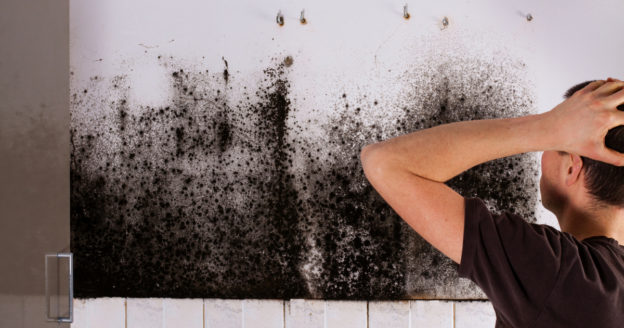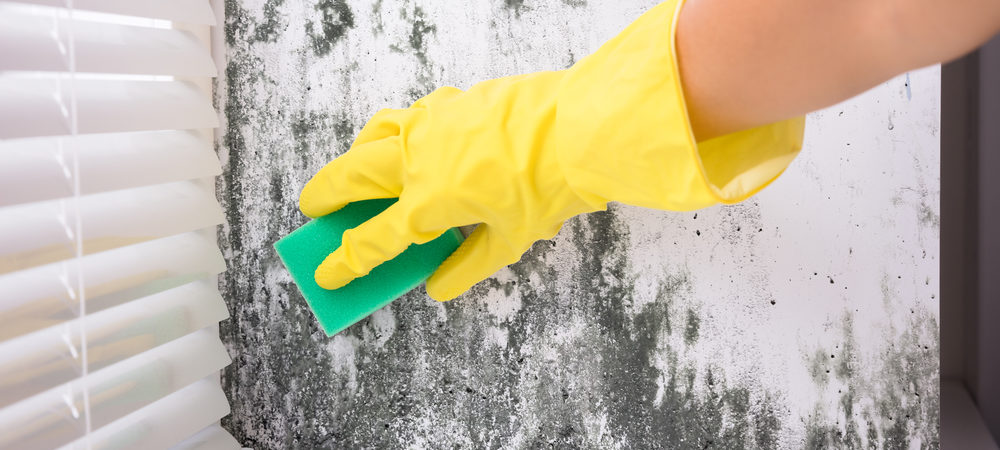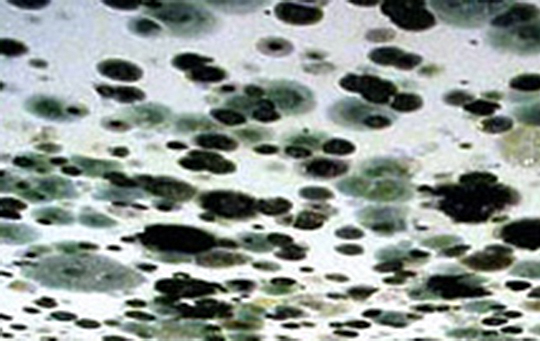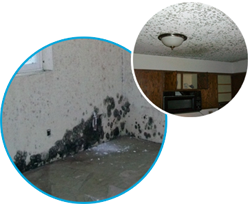THE GUIDE TO MOLD REMEDIATION FOR BUSINESS OWNERS
Mold is impossible to avoid – even in the workplace. Millions of spores are floating in the air at any given moment – needing only the slightest bit of humidity or a damp surface to propagate and spread. Mold not only poses a potential health threat to the staff working in those conditions but can compromise the integrity of a building’s structure as it feeds on (and thus, breaks down) organic matter. Walls, wallpapering, carpeting and a number of other structural elements are at risk when mold goes unchecked.
Even more problematic is when mold becomes so embedded in a surface or structure that it cannot be salvaged, and therefore it must be disposed of. If you suspect that your establishment might be afflicted by mold, time is of the essence, so it is important to act quickly. An effective remediation plan will identify the conditions that are conducive to mold growth, correct those conditions and safely oversee the removal of afflicted surfaces. If you are unsure how to proceed, this guide to mold remediation for business owners will walk you through every step of the process.
Confirming The Presence of Mold
Musty smells, leaks and faulty ventilation are strong indications that mold is likely to be present. If the presence of mold has yet to be confirmed, there are multiple ways to test for it. There are mold test kits that take samples of the air, surface, or materials of the suspected location. Culture tests can identify which particular strains of mold are present. However, as businesses may have more intricate and complicated HVAC systems, professional mold testing is recommended.
Assessing the Affected Area
Once the presence of mold has been confirmed, the extent of the damage must be assessed. This includes the size of the affected area, sources of moisture, as well as the type of materials that were damaged. Such an examination can identify whether the mold poses any immediate health risks or how intensive the remediation process will be. If the damage is extensive, the premises may have to be vacated during the remediation process.
There are four levels of mold contamination, ranging from 1 to 4. These levels are determined by the size of the contamination and determine the remediation guidelines:
Level 1: Small isolated area that’s 10 square feet or less.
Level 2: Mid-sized isolated areas between 10 and 30 square feet
Level 3: Large isolated areas are between 30 and 100 square feet
Level 4: Extensive contamination is anything greater than 100 square feet

Mould remediation standard and reference guide for public review
The Institute of Inspection, Cleaning and Restoration Certification (IICRC) is revising the IICRC ‘S520-2008 Standard and Reference Guide for Professional Mold Remediation’. The draft S520 Standard was available from 5 July to 19 August 2013 for the first round of public review, and is available now for the second round of public review and comment.
A procedural standard and reference guide for the remediation of mould damaged structures and contents, S520 is based on reliable remediation and restoration principles, research and practical experience. It attempts to combine essential academic principles with practical elements of water damage restoration for technicians facing ‘real-life’ mould remediation challenges, explains the IICRC.
The S520 is written for use by those involved in the mould remediation industry and is the result of collaboration among microbiologists and other scientists; public health professionals; industrial hygienists; remediation contractors; restoration service companies; cleaning and restoration training schools; and trade associations.
The IICRC S520 draft Standard is available for review and comment as part of the ANSI 45-day public review period from 13 March to 27 April, 2015. In addition, the draft S520 Reference Guide is also available separately during the same time period for informal peer review and comment.
Water damage guide for review
The IICRC has also been working on revising the ANSI/IICRC S500-2006 Standard and Reference Guide for Professional Water Damage Restoration. Substantive changes made to the draft Standard since the third public review in August 2014 are currently available for the fourth round of public review and comment from 6 March to 5 April, 2015.

DIY Mold Cleaning
Mold is present in all environments everywhere in the world. It is impractical to remove all mold spores from a structure with current technology. The goal of remediation is to control the levels of mold and restore the structure to a “normal” level.
Visible mold growth in a structure can produce higher than normal spore counts in the air. Mold spores may settle on surfaces and contents throughout. This increases the the chances of future mold growth, and can impact those suffering from health issues related to mold exposure.
With time, air quality should return to normal background levels after you identify the source of mold and correct it. Yet, even when you improve the air quality, there may still be elevated levels of mold spores on surfaces throughout the home. You may also reduce these surface spores over time, depending on how often you clean.
Many people, especially those with health problems, won’t want to wait for the spore counts to reduce over time. You can remove the settled spores more quickly with a thorough cleaning. To do this, you must clean all surfaces and contents in the home, or the affected area(s). There is a lot of time and labor involved, which can make hiring a contractor very expensive. We want to help you avoid that cost by telling you how you can do it yourself.
Cleaning Procedures
You will need some of the following supplies to get started. Almost all the items in this list are available at your local hardware and big box stores.
Supplies & Equipment
N-95 Disposable Particulate Masks
Disposable Nitrile Gloves
HEPA filtered vacuum – (See below)
General/All-Purpose Cleaners
Rags – Cloth
Bucket
Mop/Mop Bucket
Furniture Sliders

A Guide to Mold Remediation for Air Conditioners
Mold that accumulates inside your air conditioner exposes your family to airborne mold every time you use the system. Poor indoor air quality can lead to a number of health complications, from allergies to severe respiratory problems. If you think your air conditioner might need mold remediation, it pays to know what caused the problem and how you can keep it from happening again.
What Causes Mold Growth in Air Conditioners?
Excess moisture is the primary culprit in mold growth. Since air conditioners cycle on and off, moisture tends to collect in the ductwork and air handler. Warm, humid locations are particularly prone to moisture buildup because there’s more water vapor present.
Irregular maintenance and usage can also contribute to mold in an air conditioning unit. Dust and organic matter retain moisture and provide a breeding ground for mold. Using the system helps circulate air and prevent buildup, and routine maintenance gets rid of excess debris. Skipping these allows it to remain in place and absorb water.
What Should You Do If You Discover Mold?
Mold is a serious issue, so you need to contact a mold remediation expert if you discover it. These HVAC specialists are trained to identify the sources of mold issues and will use the proper cleaning, disinfecting, and decontaminating techniques to remove mold from the unit’s internal components and ductwork.
What Are Some Ways to Deter Future Mold Growth?
Regular maintenance is key to removing dirt, dust, and debris that can permit mold growth. Change the air filter every 90 to eliminate organic matter that collected in your unit, and use this time to inspect the system. Make sure the air conditioning coils are clean and free from damage.
Mold Remediation For Landlords
Liability is always a concern for landlords, that’s why most won’t even rent to a new applicant without conducting a proper tenant background check. Thus, it’s easy to understand why the mention of “mold” and “millions” together would give a property owner nightmares. Not only is indoor exposure to mold known to cause respiratory problems and other health issues in some individuals, but mold is everywhere — and because moisture is critical to its ability to grow to elevated levels, something as simple as a leaky pipe could prove costly.
While causation is difficult to prove, you as a landlord have enough to do without being tied up in court. And whether there is litigation or not, a prevalence of mold could lead to tenant loss.
Mold issues in buildings are a result of water/moisture problems. Mold also needs an organic food source — and many building materials serve that purpose — and high relative humidity. The water source is the easiest factor to control.
As a landlord, the mold problem is not yours alone. Mold can grow in 24 to 48 hours after a water intrusion, so the tenant bears some responsibility for notifying the landlord the mold situation or water leak exists, and for reporting water stains that indicate a leak. Tenants also should use exhaust fans and control humidity. Mold can be hidden in many places, and a landlord generally cannot be held liable unless he or she knew — or should have known — the problem existed.
If the area where mold is growing is small, researching how to clean mold as the landlord and doing the work yourself can save the cost of hiring a mold remediation specialist.

